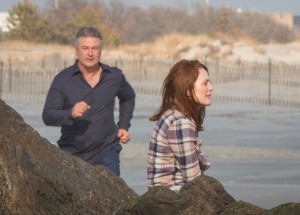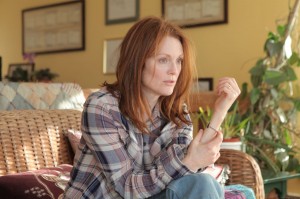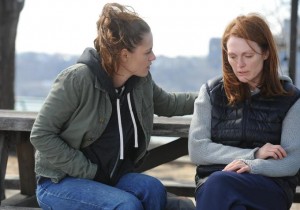 After the dismal failure of “The Last of Robin Hood,” one of the year’s worst features, writers-directors Richard Glatzer and Wash Westmoreland take a step in the right direction with “Still Alice,” a sensitive if too soft and middlebrow chronicle of a middle-age woman afflicted with Alzheimer.
After the dismal failure of “The Last of Robin Hood,” one of the year’s worst features, writers-directors Richard Glatzer and Wash Westmoreland take a step in the right direction with “Still Alice,” a sensitive if too soft and middlebrow chronicle of a middle-age woman afflicted with Alzheimer.
Based on Lisa Genova’s best-selling novel, “Still Alice” is by no means a great film, but in its good moments, it is honest, well-intentional, touching, Most important of all, and the only reason to see the movie is the astounding, multi-nuanced performance by Julianne Moore in the titular role as Alice Howland, a brilliant linguistics professor at Columbia University.
This is the Oscar card of Julianne Moore, one of the greatest losers in Academy’s annals, claiming four Oscar nominations to her credit, two in the lead and two in the supporting category. Though the secondary roles are all underwritten, there is also solid support from the able cast, comprised of Alec Baldwin as Alice’s husband, and Kristen Stewart, Kate Bosworth, and Hunter Parrish as her bright and beautiful children.
 The tale focuses on the deteriorating condition of one bright woman and the various effects of her degenerative disease on all those around her. Alice Howland is an alert and charismatic New Yorker, a 50 year old career-oriented femme, happily married to John (Baldwin), a research scientist, who admires her–“the smartest, most beautiful woman I’ve ever met.”
The tale focuses on the deteriorating condition of one bright woman and the various effects of her degenerative disease on all those around her. Alice Howland is an alert and charismatic New Yorker, a 50 year old career-oriented femme, happily married to John (Baldwin), a research scientist, who admires her–“the smartest, most beautiful woman I’ve ever met.”
The couple has three adult children: Anna (Bosworth), Tom (Parrish), and Lydia (Stewart). Some of the movie’s best scenes, including the last one, depict poignant arguments, confrontations, and reconciliations between the two generations.
When the story begins, Alice seems to have it all, successful career, fulfilling marriage, happy family, all in evidence when she celebrates (in the very first scene) her 50th birthday.
 All’s well until she begins to experience some memory problems, manifest in forgetting words mid-sentence, or scheduled events. Her condition is both tragic and ironic, as she is a Columbia linguistics professor, and language and words are her metier.
All’s well until she begins to experience some memory problems, manifest in forgetting words mid-sentence, or scheduled events. Her condition is both tragic and ironic, as she is a Columbia linguistics professor, and language and words are her metier.
Soon, Alice starts to lose her bearings in familiar places, such as the very university campus where she works. There’s a harrowing scene early one, in which Alice, a steady jogger, stands in the middle of the campus at Columbia University, totally confused and bewildered. The filmmakers grant her the kind of close-up actors dream of, but they also slow the pacing–time stands still–while circling the camera around Alice, as she were in a crossroad, trying to decided which direction to follow–literally and figuratively.
Scared, Alice consults a neurologist who rules out a brain tumor, but hypothesizes early-onset Alzheimer’s, a rare form of the disease that strikes people under 65. The first time she sees her doctor, he remains a faceless figure–for no apparent reason–we only hear his expert voice as the bearer of news that are utterly shocking.
The doctor explains that her kind of Alzheimer is rare and that it is familial–Alice had inherited her disease from her father, who died of alcoholism. More importantly, because it is genetic, her three children have a good chance of carrying the mutated gene. After conveying the bad news to her family, Alice urges them to test. And it’s here that the filmmakers make a dramatic mistake, but not showing the effects of the dreadful news on each of her children and by depicting the results of the test in a brief phone conversation, as if it is a minor incident; we don’t even see Anna’s face when she tells her mother than her brother decided not to test.
In general, as writers and directors, Glatzer and Westmoreland, err in presenting a rather schematic and contrived chronicle of deterioration, perhaps fearing to upset their viewers. End result, Still Alice is too polite and civilized as a movie, one that recalls Masterpiece Theater or a decent TV Movie of the Week, following the expected steps and phases of deterioration.
Thus, Alice’s first reaction is denial, hiding it from her loved ones. But when she shows confusion over a dinner guest, and other signs of dementia, she is forced to share her frightening condition with her family members, beginning with her husband, who at first dismisses the whole thing. Gradually, things get worse, and Alice’s mental state begins to decline rapidly. Struggling, the family members try to cope with the situation, some more successfully than others.
Throughout, Alice and her companions convey the sense of perpetual fear, dreading the future, and not knowing what to expect. And with good reason: Alice’s descent continues, with all the pain, suffering, and desperation to stay connected involved.
In several tense and intense scenes, Alice leaves suicide instructions for herself, types and retypes her name and address on her own computer, and begins to communicate with her other self, “Hi, Alice, I am you,” in front of the mirror. It’s indicate of the film’s dramatic weaknesses one the one hand, and Moore’s towering performance on the other, that the most fully realized scenes are when Alice is by herself.
Also frustrating is the way in which Baldwin’s role is (mis)conceived, relegating him to a passive listener and supportive husband. With the exception of one or two scenes, John is simply not there; he even misses a crucial event in Alice’s life.
It may be a coincidence, but Baldwin played a much better written husband role last year, in Woody Allen’s “Blue Jasmine,” for which his onscreen wife, Cate Blanchett, won the Best Actress Oscar. He may perform the same function again this year, when Moore takes the podium for her Best Actress Oscar.
Lacking sharp technical skills, which was evident in all of their films, the directors compensate with a sensitive approach, occasionally laced with humor, that could have been easily too sentimental.
That said, the last reel may present a situation that’s too hopeful considering what we know about the tragic course of deterioration. Alice is invited to address an Alzheimer’s conference, and after extensive preparation, she succeeds in delivering a moving speech about her condition, even getting applause for it.
Our grade for the film is B- or C+, but for Julianne Moore’s performance it’ s straight A.
Further Viewing:
Two recent films, both superior to “Still Alice” have centered on women suffering from similar degenerative illness: “Away from Her,” starring Julie Christie, and Michael Haneke’s “Amour,” boasting a seminal performance from Emmanuelle Riva. Both actress have deservedly been nominated for the Best Actress Oscar.
End Note
The national statistics are alarming: reportedly more than five million Americans live with Alzheimer’s disease. I was unaware that the film is really a personal one. Co-director Glatzer has been diagnosed himself with ALS, which may have contributed to the candid and insider’s view of this painful subject.
Cast:
Julianne Moore
Kristen Stewart
Alec Baldwin
Kate Bosworth
Hunter Parrish
Credits
Production companies: Lutzus-Brown, Killer Films
Directors-Screenwriters: Richard Glatzer and Wash Westmoreland
Producers: Lex Lutzus, James Brown, Pamela Koffler
Executive producers: Marie Savare, Christine Vachon, Maria Shriver, Emilie Georges, Nicholas Shumaker, Celine Rattray, Trudie Styler
Director of photography: Denis Lenoir
Production designer: Tommaso Ortino
Costume designer: Stacey Battat
Editor: Nicolas Chaudeurge
Music: Ilan Eshkeri
Running time: 99 minutes










